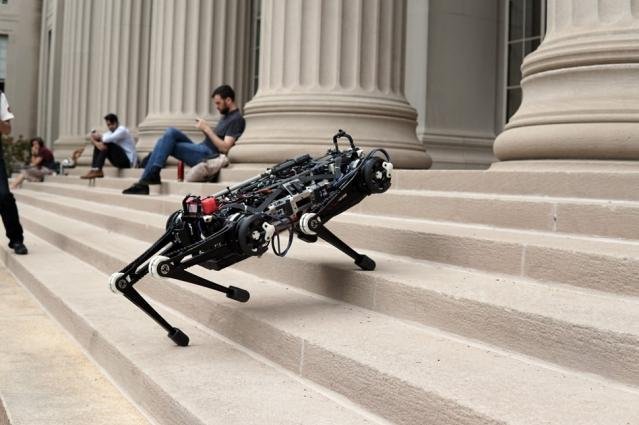Cheetha 3 can climb stairs and maneuver around obstacles without the benefit of visual sensors. Photo by MIT News
July 5 (UPI) -- Cheetah 3, a robot designed by engineers at MIT, can run, jump and climb across complex terrain, avoiding obstacles along the way -- all without the benefit of sight.
Researchers have dubbed the robot's technological abilities "blind locomotion."
Robots with similar maneuverability rely on cameras or some other kind of sensor to "see" the world, but Cheetah 3 is effectively blind. The 90-pound robot relies instead on "feel" to make its way through dynamic environs.
"Vision can be noisy, slightly inaccurate, and sometimes not available, and if you rely too much on vision, your robot has to be very accurate in position and eventually will be slow," Sangbae Kim, associate professor of mechanical engineering at MIT, told MIT News. "So we want the robot to rely more on tactile information. That way, it can handle unexpected obstacles while moving fast."
Cheetah 3's designers hope to continue building on the robot's capabilities. Eventually, they hope the robots will be able to perform dangerous tasks like power plant inspections.
"I think there are countless occasions where we [would] want to send robots to do simple tasks instead of humans," Kim said. "Dangerous, dirty, and difficult work can be done much more safely through remotely controlled robots."
Cheetah 3's ability to navigate uneven terrain, avoiding obstacles and maintaining its balance, is made possible by two new algorithms developed by Kim and his colleagues -- a contact detection algorithm and a model-predictive control algorithm.
The contact detection algorithm helps the robot ensure the stability of each step it takes. If the robot detects instability, it can decide to alter its footing accordingly. In essence, the algorithm helps the robot decide between planting its foot on the ground, or swinging it through the air.
"When it comes to switching from the air to the ground, the switching has to be very well-done," Kim said. "This algorithm is really about, 'When is a safe time to commit my footstep?'"
Using a combination of gyroscopes, accelerometers and joint positions of the legs, the algorithm is constantly anticipating the nature of the four legs' interactions with the ground. Realtime data related to each leg's interaction is fed back into the algorithm, altering the anticipation and decision-making process for the other three legs.
When powered with the algorithm, the robot can walk on a treadmill and climb a staircase, avoiding obstacles along the way.
While the contact detection algorithm helps the robot decide whether or not to make contact with the ground, the model-predictive control algorithm helps Cheetah 3 decide how much force to apply with each step. The algorithm also calculates and accounts for how this force will affect the positioning of the body and the other three legs.
Both algorithms produce predictive calculations for each leg 20 times per second.
"It's thanks to that predictive control that can apply the right forces on the ground, combined with this contact transition algorithm that makes each contact very quick and secure," Kim said.
Scientists have previously deployed Cheetah 3 with visual cameras for added perspective and understanding of its broader surroundings, but currently, engineers are committed to improving the robot's blind locomotion.
Researchers are scheduled to present Cheetah 3 and its groundbreaking navigational technology at the International Conference on Intelligent Robots, held in Madrid, Spain, in October.















